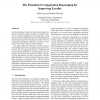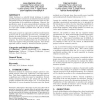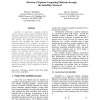307 search results - page 8 / 62 » Automated Performance Measurement of Parallel Programs |
SC
2004
ACM
14 years 2 months ago
2004
ACM
Improving program locality has become increasingly important on modern computer systems. An effective strategy is to group computations on the same data so that once the data are ...
ASPLOS
2000
ACM
14 years 29 days ago
2000
ACM
Multiprocessing is already prevalent in servers where multiple clients present an obvious source of thread-level parallelism. However, the case for multiprocessing is less clear f...
GECCO
2008
Springer
13 years 9 months ago
2008
Springer
Motivated by the ability of living cells to form specific shapes and structures, we present a computational approach using distributed genetic programming to discover cell-cell i...
SIMUTOOLS
2008
13 years 10 months ago
2008
Model checking is a suitable formal technique to analyze parallel programs' execution in an industrial context because automated tools can be designed and operated with very ...
ISPDC
2007
IEEE
14 years 2 months ago
2007
IEEE
Selection of spaceborne computing platforms requires balance among several competing factors. Traditional performance analysis techniques are illsuited for this purpose due to the...



